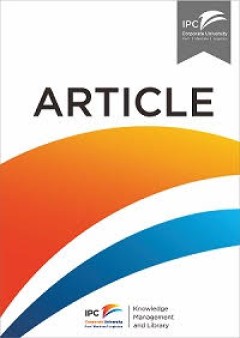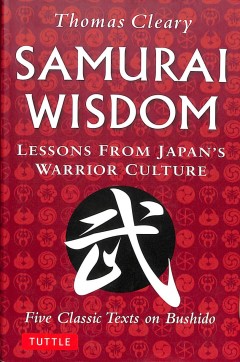Ditapis dengan

Porter's business strategies in japan
- Edisi
- Vol. 9 Issue: 1, pp. 37-44
- ISBN/ISSN
- 1751-5637
- Deskripsi Fisik
- -
- Judul Seri
- Business Strategy Series
- No. Panggil
- ATC MG ALL p
- Edisi
- Vol. 9 Issue: 1, pp. 37-44
- ISBN/ISSN
- 1751-5637
- Deskripsi Fisik
- -
- Judul Seri
- Business Strategy Series
- No. Panggil
- ATC MG ALL p

Samurai wisdom : lessons from japan's warrior culture
The ancient warrior culture of Japan produced a sophisticated martial philosophy that we know today as Bushido—the Way of the Warrior. In Samurai Wisdom, author Thomas Clearly provides five important new translations of major Japanese works on Bushido. The writings of the scholar Yamaga Soko and his disciples are among the clearest expositions we have of the core ideals and philosophy under…
- Edisi
- -
- ISBN/ISSN
- 978-0-8048-4008-8
- Deskripsi Fisik
- 256 p, 20 cm ; index
- Judul Seri
- -
- No. Panggil
- LC 170.44 CLE s

International business negotiation: automobiles and ships: CASE STUDY
The purpose of this case study is to provide an opportunity for students to conduct realistic business analysis applying subject material related to cross-cultural issues presented in the international business and international management courses.
- Edisi
- Vol. 16 No. 1, 2009 pp. 102-113A
- ISBN/ISSN
- 1352-7606
- Deskripsi Fisik
- 13 p.
- Judul Seri
- Cross Cultural Management: An International Journal
- No. Panggil
- ATC MR LOM i

An analysis of the overcapacity problem under the decentralized management sy…
This article is concerned with an analytical summary of how the Japanese container ports have been taking place overcapacity problem in a systematic way. It focuses on institutional aspects of the overcapacity problem from the viewpoint of accounting cost and opportunity cost. The ®rst issue arises due to the port authority’s accounting system and insu cient disclosures of ®nancial statem…
- Edisi
- VOL. 29, NO. 1, 3±15
- ISBN/ISSN
- 1464±5254
- Deskripsi Fisik
- 15p
- Judul Seri
- Maritime Policy & Management: The flagship journal of international shipping and port research
- No. Panggil
- ATC LO TER a

Evaluation methodologies of transportation projects in Japan
This paper examines the system and manuals for transportation project evaluation, which are recently introduced for all transportation modes, road, railway, airport and seaport projects in Japan. The manuals aim to evaluate the social signi®cance of projects from the viewpoint of ef®ciency and equity, by applying a sort of multi-criterion analysis, although adopting the cost bene®t analysis …
- Edisi
- -
- ISBN/ISSN
- 0967-0700
- Deskripsi Fisik
- 6 p.
- Judul Seri
- Transport Policy
- No. Panggil
- ATC PO UGI e

Japan’s maritime security strategy : the japan guard and maritime otlaws
- Edisi
- -
- ISBN/ISSN
- 978-1-137-38555-0
- Deskripsi Fisik
- xii, 221 p.
- Judul Seri
- -
- No. Panggil
- TXT MR BLA j
- Edisi
- -
- ISBN/ISSN
- 978-1-137-38555-0
- Deskripsi Fisik
- xii, 221 p.
- Judul Seri
- -
- No. Panggil
- TXT MR BLA j

Collaborative forecasting and planning in supply chains: The impact on perfor…
The purpose of this paper is to empirically examine the impact of internal and external collaborative forecasting and planning on logistics and production performance.
- Edisi
- Vol. 39 No. 2, 2009 pp. 84-105
- ISBN/ISSN
- -
- Deskripsi Fisik
- 25 p.
- Judul Seri
- International Journal of Physical Distribution & Logistics Management
- No. Panggil
- ATC LO NAK c

Japanese Dominance A Challenge For SGMW MPV Production
The start of local MPV production by SGMW in 2017 will bode well for the company ' sefforts to tap into the popular vehicle segment by being closer to its customer base and allowing it to be more responsive to changing market conditions. That said, the customer loyalty and market dominance of Japanese brands in the MPV segment will pose major challenges to SGMW ' s efforts at wrestling …
- Edisi
- -
- ISBN/ISSN
- -
- Deskripsi Fisik
- 6 p .
- Judul Seri
- -
- No. Panggil
- BD BMI i

US-Japan distribution channel cost structures: is there a significant differe…
The Japanese distribution system is often accused of being inefficient and responsible for high consumer prices. Discusses some critical dimensions that make distribution appear to be less efficient in Japan than the US. An empirical study compares distribution costs at all levels of the channel in the two countries, including the costs of distributing industrial products, which are ultimatel…
- Edisi
- Vol. 27 Issue: 1, pp.53-66
- ISBN/ISSN
- -
- Deskripsi Fisik
- 16 p .
- Judul Seri
- International Journal of Physical Distribution & Logistics Management
- No. Panggil
- ATC LO PIR u

System dynamics study of the Japanese automotive industry closed loop supply …
A major challenge the car industry currently faces worldwide is how to implement an effective reverse (also called closed loop) supply chain design while manufacturing environmental friendly cars from limited available resources. The purpose of this paper is to examine relationships between reduce, reuse and disposal in the Japanese car market with base scenario analysis using the car consumpti…
- Edisi
- Vol. 18 Issue: 2, pp.115-138
- ISBN/ISSN
- -
- Deskripsi Fisik
- 27 p.
- Judul Seri
- Journal of Manufacturing Technology Management
- No. Panggil
- ATC LO KUM s

Some considerations relating to the reintroduction of assembly lines in the S…
In recent years, assembly lines have been reintroduced in the Swedish automotive industry and, in many cases, have replaced those so-called alternative assembly systems which had their roots in the 1970s. This paper reviews and evaluates some explicit reasons given for the return to the assembly line. It also considers whether the decisions to replace alternative assembly systems with assembly …
- Edisi
- Vol. 24 No. 8, 2004 pp. 754-772
- ISBN/ISSN
- -
- Deskripsi Fisik
- 21 p .
- Judul Seri
- International Journal of Operations & Production Management
- No. Panggil
- ATC LO JON s

Japanese food wholesaling: us comparisons and future issues
Examines the Japanese food distribution channel structure with special emphasis on food wholesalers and food retailers. Contrasts these two areas with the comparable US functions. Reviews channel inefficiencies in Japan with attention to historical development, regulations, consumer attitudes and food shopping behaviour, transportation and logistics, transportation alternatives, consolidation…
- Edisi
- Vol. 24 Issue: 7, pp.26-34
- ISBN/ISSN
- -
- Deskripsi Fisik
- 11 p.
- Judul Seri
- International Journal of Physical Distribution & Logistics Management
- No. Panggil
- ATC LO LAW j

Are ISO 9000 and TQM routes for logistics excellence?
The value of ISO 9000 and TQM are revisited, including the relationship with logistics strategy and the four pillars of TQM. The Japanese TQM experience is put under close scrutiny, which leads to the need for TQM model. A model called TQMEX standing for a TQM EXcellence Model has been developed based on sound TQM practices. Further to a previous survey conducted on 180 UK firms, another questi…
- Edisi
- Volume 10 · Number 6 · 1997 · 275–283
- ISBN/ISSN
- -
- Deskripsi Fisik
- 11 p.
- Judul Seri
- Logistics Information Management
- No. Panggil
- ATC LO SAM a
 Karya Umum
Karya Umum  Filsafat
Filsafat  Agama
Agama  Ilmu-ilmu Sosial
Ilmu-ilmu Sosial  Bahasa
Bahasa  Ilmu-ilmu Murni
Ilmu-ilmu Murni  Ilmu-ilmu Terapan
Ilmu-ilmu Terapan  Kesenian, Hiburan, dan Olahraga
Kesenian, Hiburan, dan Olahraga  Kesusastraan
Kesusastraan  Geografi dan Sejarah
Geografi dan Sejarah